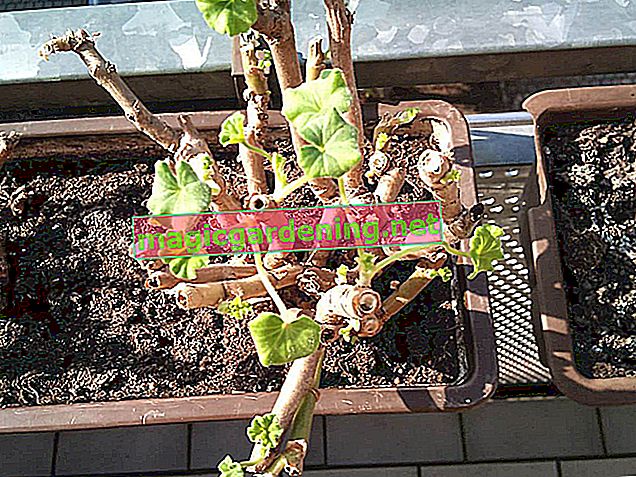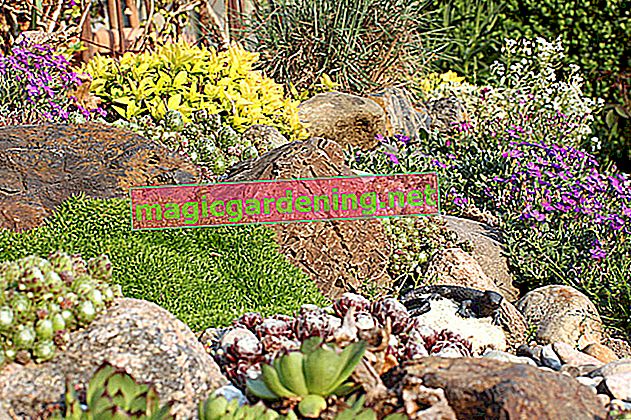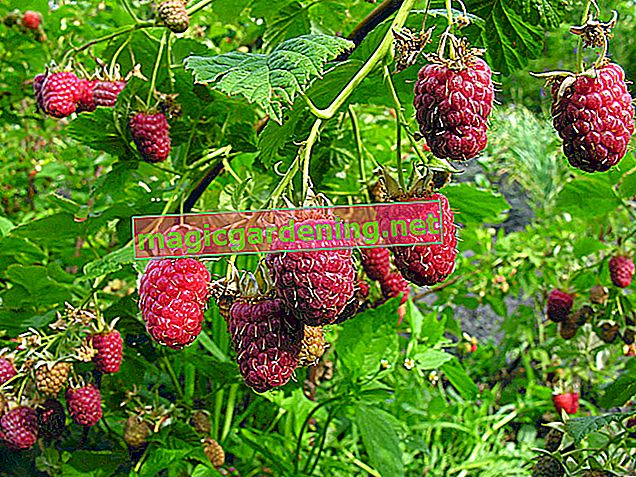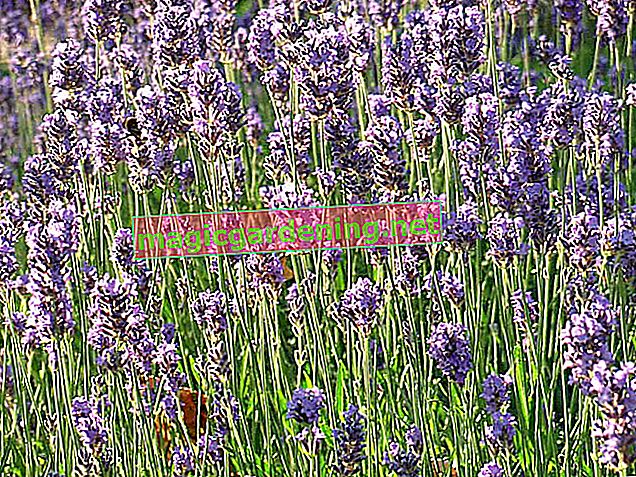
Plant imperial crown correctly
When autumn knocks on the garden gate, it is time to ensure the abundance of flowers in the herbaceous bed or the cottage garden next year. If you plant the imperial crown in this sequence between mid-August and mid-October, the chances of the first flowering as early as next year are good:
- Thoroughly loosen the nutrient-rich soil in the sunny to shady location
- Make small pits at a distance of 35-60 cm with a depth of 20-25 cm
- Scatter sand on the bottom to prevent lump rot
- Mix the excavated material with sifted compost and horn shavings
- Place one flower bulb in the soil, press the substrate on and water
also read
- The heyday of the imperial crown
- Plant the imperial crown in your own garden
- That's how poisonous the imperial crown is
Planting in the bucket is the same, but instead of sand you should use some potsherds, expanded clay (€ 17.50 on Amazon *) or grit (€ 12.80 on Amazon *) as drainage.
Continue reading
Care tips
An imperial crown is far less capricious than its exotic appearance suggests. The care program only includes the following measures:
- Repeatedly fertilize the heavily draining plant organically from March to the end of the flowering period
- Do not let the substrate dry out
- Put watering water directly on the roots
- Cut off withered flower stems to save energy for seed formation
- Only remove the leaves when they have completely yellowed and withered
In winter regions we recommend a light winter protection for reasons of caution. Before the first frost, cover the plant with a layer of foliage, which is fixed with coniferous twigs. The mulch is removed in good time before the new shoot.
Continue reading
Which location is suitable?
The flower unfolds its oriental magic to perfection in sunny to shady, warm and sheltered locations. The more sunbeams brush the plant, the more intensive photosynthesis takes place with the resulting flower sculpture. The exorbitant floral commitment of the plant also requires plenty of nutrients. Therefore, choose a location for the Kaiserkrone with nutritious, humus-rich soil, fresh, moist and first-class permeable.
The correct planting distance
To determine the best possible planting distance, take the expected growth height and halve this value. For a plant with a height of 70-80 cm, the distance is 35-40 cm. Majestic specimens that reach up to 120 cm in height are placed at a distance of 60 cm from the neighboring bed.
What soil does the plant need?
The imperial crown is dependent on constant access to nutrients in order to meet expectations as a magnificent flower. So settle the plant in this soil:
- Rich in nutrients
- Humorous and sandy-loamy with a fresh, moist consistency
- Well-drained, loose and profound
In the planter, the flower stages an exotic flair if it is given a high-quality and structurally stable potted plant soil.
What is the best time to plant?
The optimal planting time for the royal onion flower is from mid-August to mid / late October. The earth is still warm from the summer sun and richly populated by busy soil organisms. In this perfect soil, the subterranean perennial organ establishes itself in good time before winter and stretches out its roots.
Continue reading
When is the flowering time?
From April to mid / late May, the magnificent flower spoils us with its unmistakable bloom. So that there is no floral dreariness at the location in the following years, cleverly chosen plant neighbors should be on the spot. The carpet-forming Clematis Praecox is very suitable or comparable, summer-blooming ground cover.
Continue reading
Cut the imperial crown correctly
Thanks to its winter-resistant onion, the imperial crown thrives as a perennial in the bed for many years. So that the plant can play this botanical map perfectly, professional cutting moves into the focus of the care program. How to do it right:
- Use a sharp, disinfected knife to cut off the wilted flower stalks together with the tuft of leaves
- Leave the lanceolate leaves on the plant until they are completely absorbed
Please do not only consider the high toxicity of this plant when cutting imperial crowns. Be sure to wear gloves and long-sleeved clothing for all maintenance work on this flower. The clippings should immediately be covered with leaves on the compost so that no animals feast on them and suffer fatal poisoning.
Continue reading
Pour imperial crown
Keep an eye on the substrate surface of imperial crowns. When the top 2-3 cm dry, the flower is watered. Give the water directly to the roots, because irrigation will impair the impressive bloom. In the bucket culture, the daily thumb test provides more information about the current watering requirements. Experience has shown that the watering can is used more often here than in the bed.
Fertilize imperial crown properly
In the context of the nutrient supply of an imperial crown must not be skimpy, because you are looking after a heavy eater. At the beginning of budding, give a well-measured portion of compost with horn shavings (€ 6.39 on Amazon *) and add nettle manure over it. This fertilization is repeated every 14 days until the end of the flowering period. Alternatively, you can provide the plant with a slow release fertilizer in the specified dosage. In the pot, the flower thanks the regular application of liquid fertilizer with vital flowering pleasure.
Pests
Since the imperial crown is a member of the lily family, the crafty lily chicken always has the flower in its sights. Look out for the 6-8 mm small, shiny red beetles from the end of March. While the pests nibble on the leaves, they lay the eggs on the plant at the same time so that the voracious larvae attack them as the process progresses. How to keep the plague in check:
- Read the beetles regularly
- Spray the infested plant several times with wormwood or tansy tea
- Protect the onions with neem preparations
If the pressure of infestation gets out of hand, specialist retailers offer effective insecticides. This includes Compo Pest-Free Plus or Lizetan Pest-Free from Bayer Garten.
Overwinter
In the year of planting and in rough locations every year, we advise you to take preventive protective measures. So that frost and moisture do not damage the plant, cover it with leaves and fir fronds from the first frost to mid / late February. In the pot, you carry the drawn-in flower to the frost-free winter quarters so that the onion does not freeze through behind the relatively thin walls of the container.
Propagate imperial crown
In order for more specimens of this royal flower to thrive in the garden, the plant supplies suitable propagation material on its own. If you dig up the onion in September / October, you will recognize several daughter onions at the base at a glance. As offspring, they have the potential to become a splendid imperial crown if they are treated as follows:
- Clean the dug out onion from soil and place on a firm surface
- Cut off the bulbs with a sharp knife
- Fill small pots with standard or prickly potting soil, plant a daughter onion and let it root
- Alternatively, put the tubers in loose garden soil in a sunny location
In contrast, sowing seeds is a horticultural adventure. The cold germs must first be subjected to a stratification in order to then care for them over a longer period of time until several pairs of leaves have developed. Several years of patience are required until the first bloom.
How do I transplant properly?
After 3 to 4 years in the bed, the imperial crown has largely worn out. Transplanting and dividing now acts like a makeover on the flower beauty. Dig up the onion between July and September and place it on a firm surface. The easily visible bulbs are cut off with a knife or spade. After the soil has been optimized with compost at the previous location and at the new location, plant the mother onion and its daughters again.
Is Crown Imperial Poisonous?
Botanically classified as a lily family, the imperial crown is poisonous for humans and animals. A high content of steroid alkaloids is essentially responsible for this. Consumption of small amounts of leaves, flowers or onions is harmful to health. It leads to nausea, vomiting and life-threatening cardiovascular complaints. Therefore, do not cultivate the flower in the family garden or on the balcony when children and pets are in the immediate vicinity.
Continue reading
Imperial crown does not bloom
If our hopes for a dreamlike abundance of flowers come to nothing, the following causes are behind the dilemma:
- Low-light location - solution: transplant to a sunny location
- Compacted soil - solution: Optimize the soil with compost and sand
- Planting too deep - solution: dig up the bulb and reinsert it a maximum of 25 cm deep
- Nutrient deficiency solution: Apply an immediately effective mineral-organic fertilizer
Last but not least, the flower requires a little patience until the first bloom. Even with the most careful planting, flowering in the first year is not guaranteed. A plant propagated from seedlings even takes up to 5 years before it presents its corolla to us.
Continue reading
How does the Imperial Crown drive out voles?
With an unpleasant garlic odor emanating from the onions, the imperial crown warns approaching enemies of their high toxicity. This is why troubled hobby gardeners swear by the flower as a biological deterrent against voles and moles. Since it is a hardy plant, the onion has this helpful effect all year round. With a single specimen, however, you will hope in vain that the pests will not appear. Only in larger groups does the disgusting smell accumulate so much that the rodents run away.
Nice varieties
- Aureomarginata: Breathtakingly beautiful with variegated, creamy-yellow leaves and scarlet flowers
- Garland Star: A majestic specimen with orange-red flowers and a height of up to 120 cm
- Vivaldi: Yellow-orange flowering plant, which thanks to its compact silhouette is well suited for the container
- Rubra Maxima: A red-orange rarity that gives the cottage garden a noble touch; Height of growth 60-100 cm
- Chopin: The flower captivates with its delicate shape and elegant blooms in muted red; Growth height 60-70 cm








